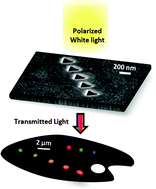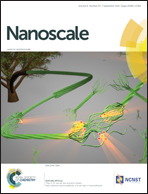Hybridization between nanocavities for a polarimetric color sorter at the sub-micron scale†
Abstract
Metallic hole arrays have been recently used for color generation and filtering due to their reliability and color tunability. However, color generation is still limited to several microns. Understanding the interaction between the individual elements of the whole nanostructure may push the resolution to the sub-micron level. Herein, we study the hybridization between silver nanocavities in order to obtain active color generation at the micron scale. To do so, we use five identical triangular cavities which are separated by hundreds of nanometers from each other. By tuning either the distance between the cavities or the optical polarization state of the incoming field, the transmitted light through the cavities is actively enhanced at specific frequencies. Consequently, a rainbow of colors is observed from a sub-micron scale unit. The reason for this is that the metallic surface plays a vital role in the hybridization between the cavities and contributes to higher frequency modes. Cathodoluminescence measurements have confirmed this assumption and have revealed that these five triangular cavities act as a unified entity surrounded by the propagated surface plasmons. In such plasmonic structures, multi-color tuning can be accomplished and may open the possibility to improve color generation and high-quality pixel fabrication.


 Please wait while we load your content...
Please wait while we load your content...